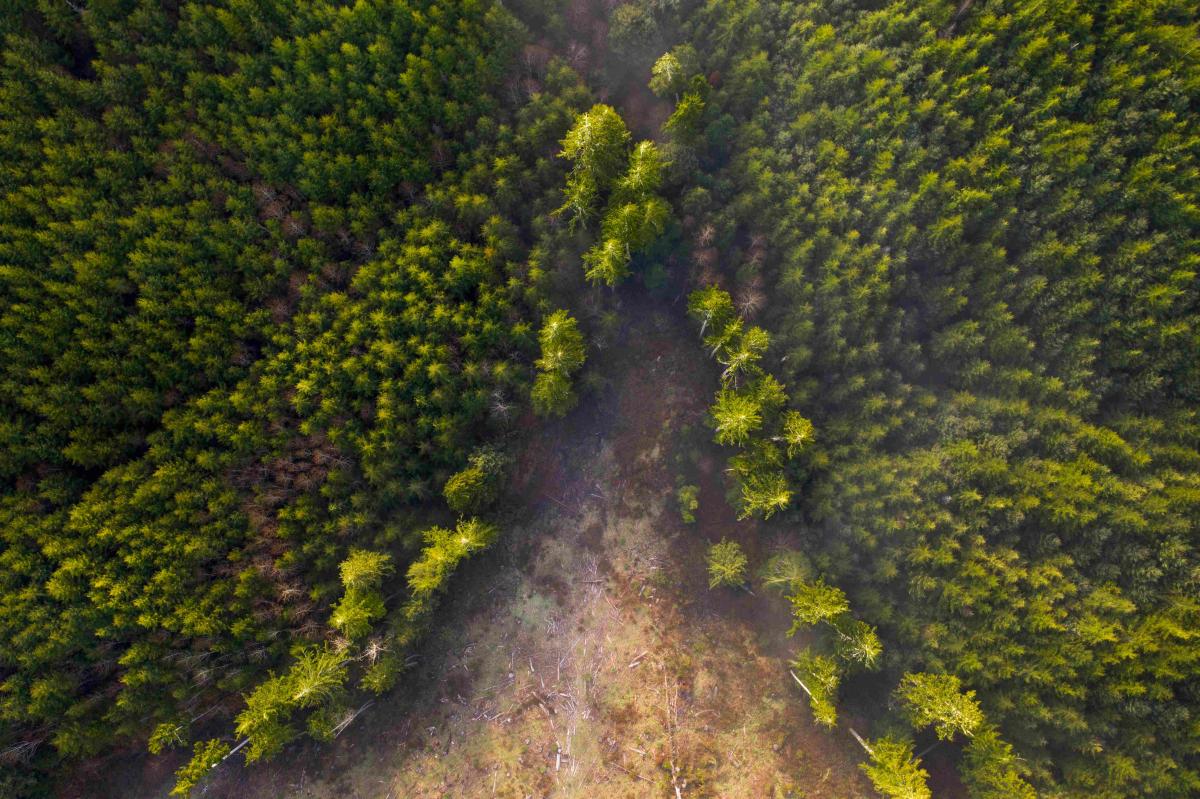As a natural carbon sink, forests are central to our fight against climate change. At the same time, forests are under immense pressure, from increasing harvest demands to natural disturbances associated with the warming climate. What can be done to increase the forest carbon sink?
Forests have an incredible ability to store carbon – both below ground in the soil and roots – and above ground in the tree’s trunk and branches, making them an important ally in the fight against climate change. The forest sector is highlighted in the Paris Agreement as one of the key components in climate change mitigation. The European Union (EU) also relies on forests to stay on track with their climate targets.
Forest soil stores three times more carbon than the trees above ground.
One example is the EU Forest Strategy 2030, which seeks to increase the quantity and quality of natural carbon sinks in Europe, by planting new forests and halting deforestation. Similarly, the EU’s new regulation for the land-use sector (LULUCF) aims to increase the forest carbon sink by 42 million tonnes of CO2 equivalents by 2030, compared to 2016-2018, bringing the total net sink to 310 million tonnes of CO2 equivalents. To help achieve this goal, LULUCF introduces targets and improved monitoring requirements for all EU member states.
Besides their ability to store carbon, forests perform a variety of positive functions for natural and human life. They provide livelihoods, recreation, and mental and physical wellbeing for people. Forests also provide habitats and host biodiversity, conserve soil and prevent land degradation. They help in adapting to climate change, and protect against natural disasters such as floods.
The forest carbon sink, however, is currently exhibiting concerning signs of diminishing capacity. Between 2010 and 2020, the EU’s total carbon sink from forests and their soil decreased by nearly a third, from approximately 430 to 290 million tonnes of CO2 equivalent per year.1 The decrease in the forest carbon sink has been attributed to increasing harvests, stress factors, and to the natural ageing of the forests. Climate change is putting forests under growing pressure through climate extremes and increased natural disturbances such as wildfires, droughts, and insects. This article explores ways in which European forest carbon sink could be strengthened in the face of conflicting demands and new risks posed by climate change.
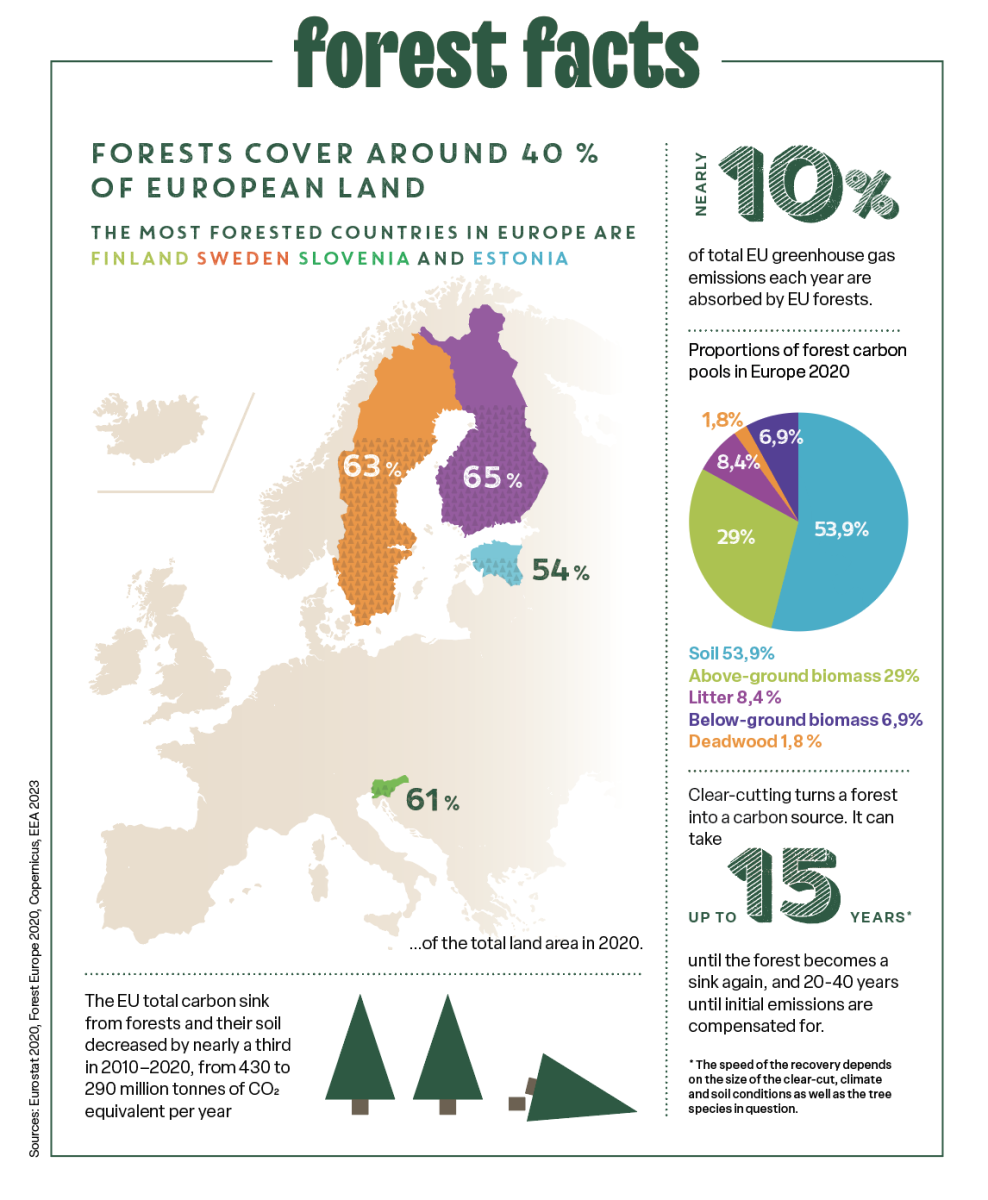
Clear-cutting increases greenhouse gas emissions
The EU’s boreal region, consisting of most of Sweden and Finland, and all of Estonia, Latvia and Lithuania, is a major timber-producing region, with most of the land dedicated to commercial forestry. The dominant form of forest management in this region is rotation management, where forests are managed in cycles called rotation periods, with clear-cutting towards the end of the rotation. Rotation-managed forests are typically less biodiverse compared to natural forests, and they are generally less resilient to natural disturbances such as storms, insects and droughts.
Clear-cutting increases greenhouse gas emissions, transforming the forest from a carbon sink into a carbon source. After a clear-cut, it takes 10-15 years for forest in temperate and boreal regions to become a carbon sink again, and 20-40 years until initial emissions associated with the clear-cut are compensated for2,3,4.
The speed of the recovery depends on the size of the clear-cut, local climate and soil conditions as well as the tree species in question.
Clear-cutting is heavily restricted by law in many parts of central and southern Europe largely due to the risk of increasing soil erosion, particularly in mountain areas. In the Nordic countries, however, it remains a widely used method.
“Some researchers and forestry experts say that clear-cutting is not harmful because you still have carbon uptake on the landscape level. For me, this is a weak argument, because by improving the carbon uptake in all forests [by avoiding clear-cuts], the total carbon uptake of this landscape would be higher,” says Dr Patrik Vestin, Research Engineer at Lund University in Sweden. “Harvesting operations can also increase the risk of storm damages in thinned stands and in stands surrounding clear-cuts.”
Selection harvesting is an alternative to rotation management. Harvest removals by this type of management are made by selectively harvesting individual trees or small groups of trees and retaining the rest of the trees in the forest. The method is considered less intrusive to the forest ecosystem, particularly regarding soil, which is one of the important components of the forest carbon sink.
“Forest soil stores three times more carbon than the trees above ground,” adds Dr Manuel Acosta, Senior Scientist from Global Change Research Institute CAS - CzechGlobe “The less you disturb the soil, the better.”
Around half of the forests in the EU are privately owned and, according to Patrik Vestin, the benefits of selection harvesting are usually the biggest for private forest owners. “The cost of harvesting is higher in the selection system, but the total cost is most likely lower. The slightly higher harvesting costs are probably compensated for by the avoided costs of soil scarification, planting, thinnings etc. associated with the rotation system.”
Clear-cutting has historically been favoured due to cost-efficiency and its ability to produce high yields and financial gains.
”A commonly-heard statement in the Swedish debate is that selection-managed forests grow 10-20% slower compared to rotation-managed forests,5” says Prof. Anders Lindroth, from Lund University in Sweden. “This has been challenged in several studies, including a Finnish modelling study which showed that carbon budget in selection-managed forests was on average 35% higher over a 100-year period compared to that of rotation-managed forests.”6
”There is no consensus that selection-managed forests would have a larger net carbon sink on the long-term, compared to rotation-managed forests, but there are some results that point in that direction,” Lindroth summarises. ”Most research is done on rotation-managed forests, so selection management needs to be studied more.”
Choosing a certain method permanently is not strictly necessary, some researchers argue. Instead, owners should select the method according to what is best for a forest at a certain point in time. National forestry recommendations in Finland, for example, have as many as 12 different types of forest management methods, and emphasise that choosing the harvesting methods should be a free choice.
Whether clear-cuts should be avoided or not divides experts. Some are in favour of multi-objective forest management, which allows for small clear-cuts as well, while others support dramatically reducing the clear-cuts.
“Sweden and Finland are in a fantastic position to meet the climate mitigation targets,” Anders Lindroth points out. “For me, reducing clear-cuts and having a financial system where landowners are compensated for storing carbon would be the best way to meet these targets.”
Forests do more than just store carbon
Climate change poses many risks to overall forest health. Degradation of forest health can lead to a phenomenon known as forest dieback, where forests start to die without a visible cause.
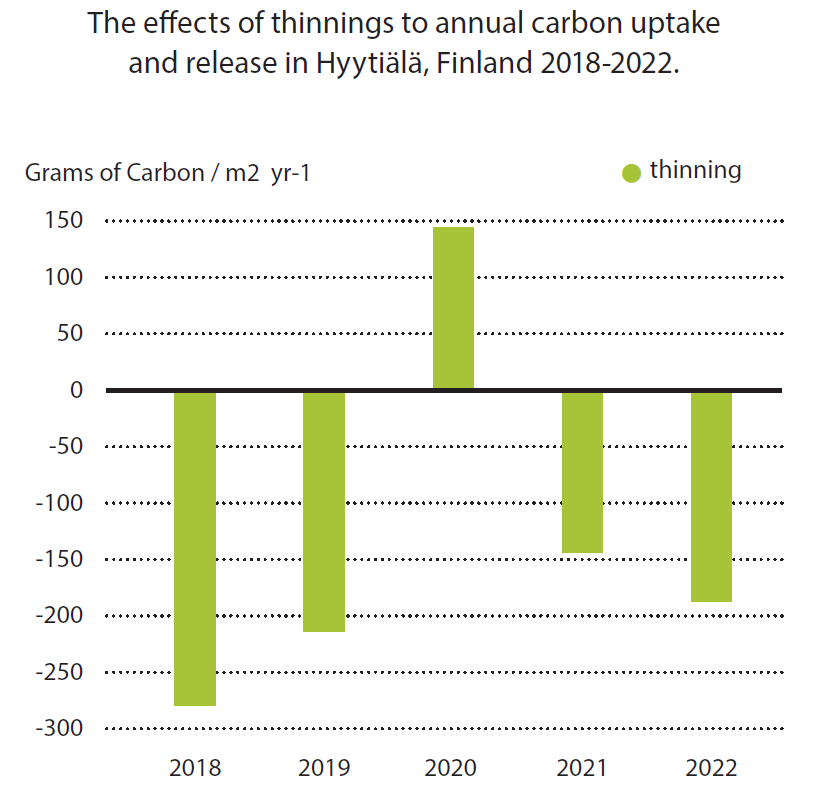
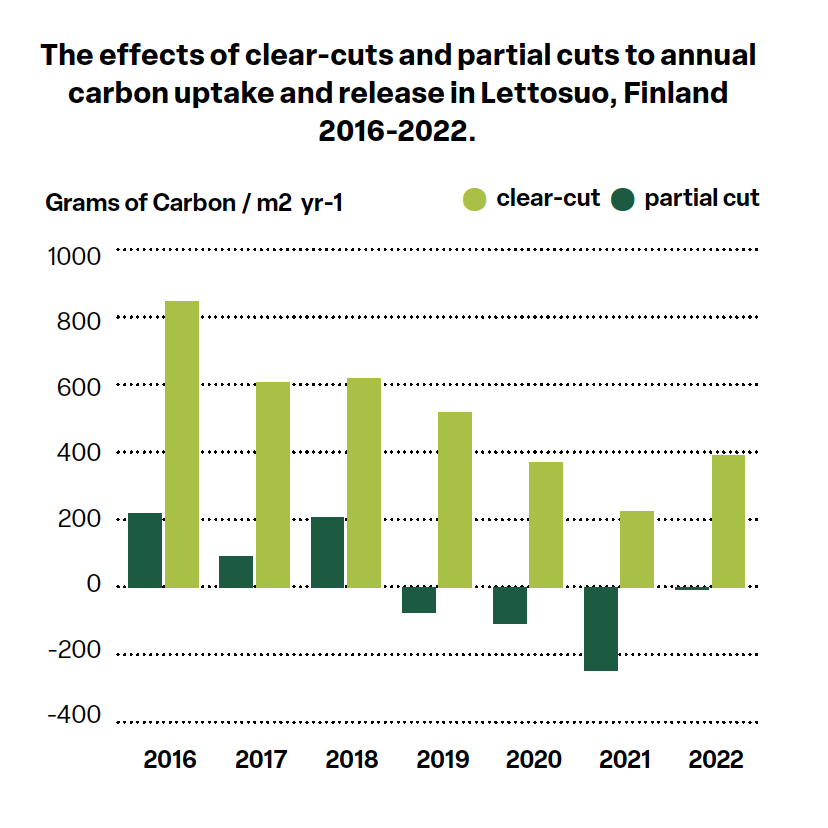
“Large-scale diebacks would not only disrupt biodiversity and carbon storage but the overall forest bioeconomy,” says Dr Sebastian Luyssaert, Associate Professor from Vrije Universiteit Amsterdam. “We have seen this with storms before, such as the Gudrun storm in Sweden, that have suddenly destroyed so much wood that the market was disrupted for several years.”
Luyssaert argues that merely increasing carbon sinks can be dangerously short-sighted and that by focusing only on one aspect, we risk repeating the mistakes of the past. Production-oriented forest management in Europe over the last 100 years has led to monoculture forests, which are now increasingly vulnerable to climate change. More recently, attempts to increase wood production and carbon stocks in southern Europe through planting eucalyptus forests have led to an increased risk of wildfires.
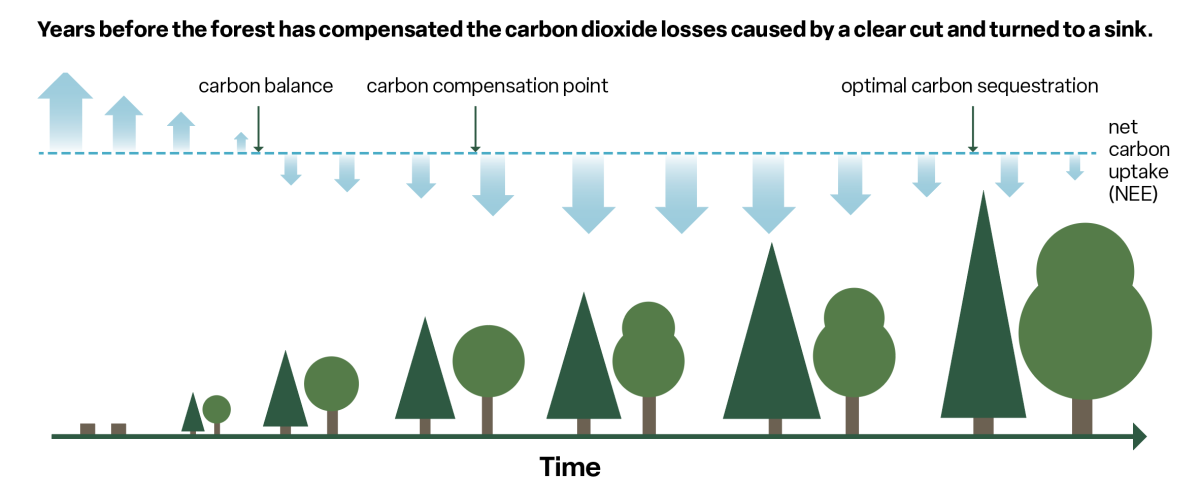
“From a pure carbon storage point of view, monoculture could be a way to go, but from all the other aspects, it’s not working. Biodiversity in these types of forests is extremely low, risk of fire is higher, and erosion will likely happen because of the very short, 12-year rotation periods,” he says. “These are the kinds of problems we run into when we only focus on one aspect of the forest ecosystem.”
“The carbon sink is important, but should not be the only focus,” agrees Dr Giacomo Grassi, Senior Scientist at the Joint Research Centre (JRC) of the European Commission. “We need to find win-win solutions between maximising the sink and adapting the forests to climate change. Resilient forests are a prerequisite for any mitigation strategy.”
Biodiversity is key for resistant forests
One cautionary tale of neglecting biodiversity can be taken from the Czech Republic, which between 2017 and 2019 was the epicentre of an extreme spruce bark beetle epidemic. The outbreak, caused by droughts that had weakened the natural defence mechanisms of the trees, damaged 3-5% of the forests planted with Norway spruce-trees distributed in low to medium elevations. Some regions encountered total destruction of these forests. A decrease in timber price, an excessive workload, and other cascading effects caused large revenue losses, requiring state interventions amounting to around 260 million euros.7
Losing that much forest in less than a year was a shock to society.
Dr Manuel Acosta, Senior Scientist, Global Change Research Institute CAS - CzechGlobe
“Losing that much forest in less than a year was a shock to society,” explains Manuel Acosta. “Now that people could see the consequences of climate change, landowners started to listen and change the composition of the Czech forests. Preventing future bark beetle attacks is now a priority in the national forest policies.”
The Norway spruce forests in Czech Republic, which were impacted by the bark beetle, were particularly vulnerable because of the species’ high sensitivity to droughts, which in turn diminished their resistance to the insects. Having large forests of just this one species helped the bark beetle to spread freely from one tree to the next. Acosta recommends always matching the tree species to the site conditions, specifically in regard to the water supply.
“When you keep the forest in good condition and have a high level of biodiversity, the whole ecosystem benefits. The research undertaken with data from the ICOS station Lanžhot – which we call the Amazon of Czech forests thanks to its incredible biodiversity – is a good example of the importance of a mixed forest.”
Old forests important for carbon storage and biodiversity
Old forests can store carbon for centuries and thus play a significant role in climate mitigation.8 Additionally, old forests are important for biodiversity. They are recognised as one of the species’ richest ecosystems in the European Union, and are very rare. The EU Biodiversity Strategy aims to protect these forests completely.
“There’s an absolute need to increase the preservation of our last pristine forest ecosystems,” Patrik Vestin emphasises. “Both for carbon storage and biodiversity.”
Forests are often harvested too young. In Finland and Sweden, for example, forests are harvested by clear-cutting usually between 45 and 100 years after initial planting, depending on site productivity and geography. In many cases trees are harvested quite close to the minimum age, although trees are able to sequester carbon for much longer. A recent study concluded that the optimum age for harvest in the boreal region was in fact between 138-155 years9, and at that age, the trees were still resistant towards natural disturbances. Longer rotation periods would thus be very beneficial for carbon sequestration and climate change mitigation.10
Allowing forests to grow for longer in one location could, however, increase the pressures for harvest elsewhere. Intensive forestry in a limited area has been seen as a possible way to satisfy the need for timber but take the pressure off other types of forests. The sole purpose of this type of plantation forestry is to produce large amounts of wood. Plantation forestry has been practiced in southwestern Europe, but experts say their placement should be considered carefully.
“These types of forests should not be planted on the most fertile land so that they don’t conflict with food production,” says Dr Giorgio Matteucci, Research Director at the National Research Council of Italy. “Public opinion is often against this plantation forestry because of their artificial nature, but for the sake of reducing the burden of wood production from the natural forests, they could be considered.”
In scientific debates, plantation forests have often been viewed rather negatively because of their low biodiversity. Proponents of this type of forestry argue, however, that problems can be avoided with proper management. Water and fertiliser use should be considered carefully, and the species should be selected for their ability to maintain or enhance the capacity of the forest to adapt to climate change.10
We should not overestimate the contribution of forests and their timber resources in climate change mitigation.
Dr Clemens Blattert, Scientist, WSL
“In some countries, such as Brazil and China, plantation forests provide most of the wood needed for industrial use, including pulp and paper. This has reduced the exploitation of natural forests,” Matteucci adds. “In Brazil, there is a serious problem of deforestation of the tropical forests, but this is caused mostly by agriculture and meat production, and not by plantation forestry.”
Forest strategies produce diverse outcomes
Though the LULUCF regulation impacts legislation across the EU Member States, the EU has no common forest policy in place, as forests were not included in the Rome Treaties. Agriculture, on the other hand, has been regulated with binding Common Agricultural Policy (CAP) in place since the 1960s. Forestry has been viewed under the competencies of each EU member state.
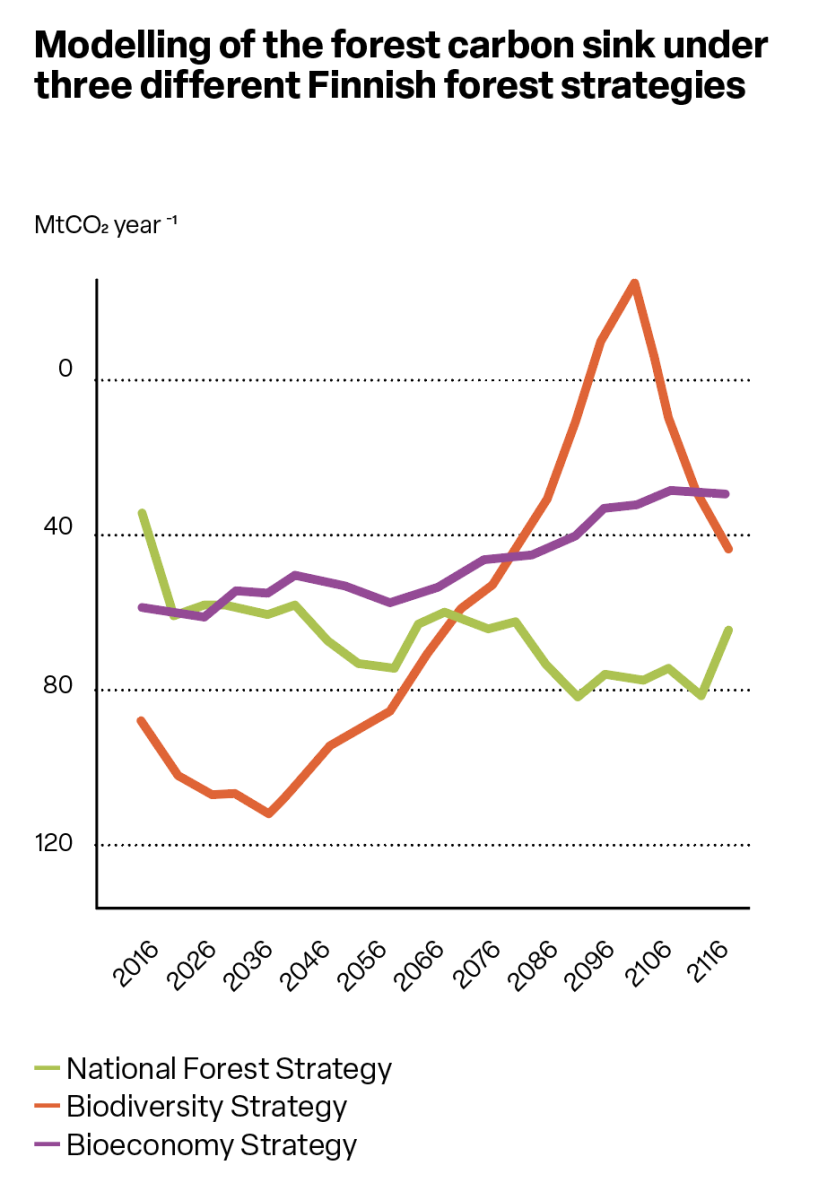
Finland, which is one of the EU’s most forested countries, has three different forest policies: the National Forest Strategy, the Bioeconomy Strategy, and the Biodiversity Strategy, which all have rather different emphases. A recent modelling study explored the consequences of pursuing the multiple objectives stated in these three Finnish forest strategies over a 100-year period.¹⁵ From the perspective of the carbon sink, the National Forest Strategy produced the best outcome.
“The scenario representing the National Forest Strategy was the only one that included carbon sinks in the optimisation, while the other two addressed it more indirectly. It also emphasised selection harvesting more than the other two scenarios,” explains Dr Clemens Blattert, the lead author of the study. “The Biodiversity Strategy, additionally, allowed for some harvests after reaching conservation targets, which is why you see a big increase in the graph around the 2080s.”
We need a combination of local solutions to maintain and, whenever possible, increase the forest carbon sink.
Dr Giacomo Grassi, Senior Scientist, JRC
Tradeoffs are normal for forestry, says Giacomo Grassi. “The debate around forestry is often quite polarised in Europe,” he says. “People want more nature and biodiversity, but at the same time, they want wood to be used to spur economic growth and the bioeconomy. The best strategy maximises all these factors in policy-determined timeframes.”
The forest carbon sinks are under a lot of pressure
The EU climate neutrality target for 2050 includes the increase of EU carbon sinks by 42 Mt CO2e by 2030. The reality is, though, that the forest carbon sink cannot be increased indefinitely nor replace emission reductions in other sectors.
“This is indeed a challenging target,” says Lucia Perugini, Senior Scientific Manager at The Euro-Mediterranean Center on Climate Change. “The forests in Europe are ageing, and facing a lot of pressure from natural disturbances. If you look at the projections, the forest sink is either stable or decreasing.”
Perugini points out that increasing the forest sink is needed to counterbalance emissions that are hard to abate, such as emissions from agriculture. To incentivise forest owners to increase their carbon sinks, the EU is developing a regulation for carbon removal certification (see the carbon farming article in this edition of FLUXES).
“We need a combination of locally-determined solutions to maintain and, whenever possible, increase the forest carbon sink, while taking into account resilience and adaptation needs,” says Grassi. “Solutions might include increasing afforestation, stimulating forest growth, or extending rotation lengths. They could also include climate-smart uses of wood, such as a shift towards more long-lasting wood products and improvement of the cascading use of wood over direct energy use.”
To fully assess the effectiveness of any actions, and to change course if necessary, we need up-to-date information on how our actions impact the forest carbon sink.
“You cannot determine where to go next if you do not know where you are now,” Grassi says. “We need timely monitoring of our actions in different locations and over long periods of time.”
This is where the ICOS research infrastructure can come into play. ICOS has almost 100 ecosystem stations all around Europe making continuous measurements of greenhouse gases in croplands, grasslands, forests and more. ICOS data can be used for modelling and verifying emissions.
“The greenhouse gas inventories used by the EU are tied to IPCC guidelines. The eddy covariance method, used by ICOS to measure the CO2 uptake and release, is not fully recognised by IPCC, meaning ICOS cannot directly contribute to the inventory,” Lucia Perugini says. “Regardless, ICOS can definitely provide data for the modelling of forest dynamics, which can then be used by the countries when reporting their emissions for the United Nations Framework Convention on Climate Change (UNFCCC).”
While forests have their part to play, climate scientists unanimously agree on one thing – we need to keep reducing our use of fossil fuels.
“We should not overestimate the contribution of forests and their timber resources in climate change mitigation,” Clemens Blattert says. “We need to decarbonise society and reduce carbon output, not solely rely on forests.”
Dr Natalia Kowalska, Principal Investigator at ICOS station Lanžhot and Dr Daniel Burgas, Senior Researcher from the University of Jyväskylä, were also interviewed for this article.
References
1 EEA 2023 EEA. Annual European Union greenhouse gas inventory 1990-2021 and inventory report 2023. Submission to the UNFCCC Secretariat. EEA/PUBL/2023/044. 2023.
2 Coursolle, C., Margolis, H. A., Giasson, M. A., Bernier, P. Y., Amiro, B. D., Arain, M. A., ... & Lafleur, P. M. (2012). Influence of stand age on the magnitude and seasonality of carbon fluxes in Canadian forests. Agricultural and Forest Meteorology, 165, 136-148
3 Lindroth, A., Lagergren, F., Grelle, A., Klemedtsson, L., Langvall, O. L. A., Weslien, P. E. R., & Tuulik, J. (2009). Storms can cause Europe-wide reduction in forest carbon sink. Global change biology, 15(2), 346-355.
4 Grelle, A., Hedwall, P. O., Strömgren, M., Håkansson, C., & Bergh, J. (2023). From source to sink–recovery of the carbon balance in young forests. Agricultural and Forest Meteorology, 330, 109290
5 Lundqvist, L. (2017). Tamm review: selection system reduces long-term volume growth in Fennoscandic uneven-aged Norway spruce forests. Forest ecology and management, 391, 362-375
6 Díaz-Yáñez, O., Pukkala, T., Packalen, P., & Peltola, H. (2020). Multifunctional comparison of different management strategies in boreal forests. Forestry: An International Journal of Forest Research, 93(1), 84-95.
7 Hlásny, T., Zimová, S., Merganičová, K., Štěpánek, P., Modlinger, R., & Turčáni, M. (2021). Devastating outbreak of bark beetles in the Czech Republic: Drivers, impacts, and management implications. Forest Ecology and Management, 490, 119075.
8 Luyssaert, S., Schulze, E. D., Börner, A., Knohl, A., Hessenmöller, D., Law, B. E., ... & Grace, J. (2008). Old-growth forests as global carbon sinks. Nature, 455(7210), 213-215.
9 Peichl, M., Martínez-García, E., Fransson, J. E., Wallerman, J., Laudon, H., Lundmark, T., & Nilsson, M. B. (2023). Landscape-variability of the carbon balance across managed boreal forests. Global Change Biology, 29(4), 1119-1132
10 Freer-Smith, P. H., Muys, B., Bozzano, M., Drössler, L., Farrelly, N., Jactel, H., ... & Orazio, C. (2019). Plantation forests in Europe: challenges and opportunities (Vol. 9, pp. 1-52). Joensuu, Finland: European Forest Institute.
11 Blattert, C., Eyvindson, K., Hartikainen, M., Burgas, D., Potterf, M., Lukkarinen, J., ... & Mönkkönen, M. (2022). Sectoral policies cause incoherence in forest management and ecosystem service provisioning. Forest Policy and Economics, 136, 102689.
12 ICOS RI, 2023. Ecosystem final quality (L2) product in ETC-Archive format - INTERIM release 2022-2. https://doi.org/10.18160/NYHT-5XZ3
13 Korkiakoski, M., Ojanen, P., Tuovinen, J. P., Minkkinen, K., Nevalainen, O., Penttilä, T., ... & Lohila, A. (2023). Partial cutting of a boreal nutrient-rich peatland forest causes radically less short-term on-site CO2 emissions than clear-cutting. Agricultural and Forest Meteorology, 332, 109361. https://doi.org/10.5281/zenodo.7092266.
14 Lindroth, A. (2023), Clarifying the carbon balance recovery time after clear-cutting. Glob Change Biol. https://doi.org/10.1111/gcb.16771
15 Blattert, C., Eyvindson, K., Hartikainen, M., Burgas, D., Potterf, M., Lukkarinen, J., ... & Mönkkönen, M. (2022). Sectoral policies cause incoherence in forest management and ecosystem service provisioning. Forest Policy and Economics, 136, 102689.
Data citations
Figure 3. ICOS RI, 2023. Ecosystem final quality (L2) product in ETC-Archive format - INTERIM release 2022-2. https://doi.org/10.18160/NYHT-5XZ3

